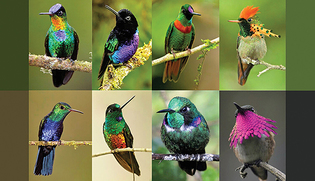
Reproduced with permission of Glenn Bartley; Wilmer Guiceno (bottom, second from right); John Cahill (bottom right).
Hummingbirds dart, then hover, before a flower’s soft opening: “The meteor that thrusts in with needle bill,” wrote Robert Frost. Their colors luminesce as if by some internal source of energy. And yet we humans see just a fraction of their beauty.
All birds are tetrachromatic, which means that the cones in their eyes register four colors—not only red, green, and blue, but also ultraviolet (or violet). “Birds can see all kinds of color mixtures that we’re incapable of seeing,” says Richard Prum, a professor of ornithology, ecology, and evolutionary biology at Yale. “UV-yellow, for instance, is as different from yellow as purple is from red or blue. That’s as precise a way as we have for describing it.”
In new research on the colors displayed by hummingbirds, Prum and Yale College graduate Gabriela Venable ’19 (now a graduate student at Duke University) found a startling result: the range of colors in hummingbird plumage exceeds the color diversity of all other bird species in total.
How hummingbirds accomplish this is straightforward. Though many animals rely on pigment to create colors, the vast majority of hummingbird coloration comes through nanoscale structures in their feathers. Hummingbirds, along with a few other birds, such as starlings and pheasants, possess a distinctive air-filled structure in the smallest branches of their feathers that allows them to create brilliant colors with less material.
“These structures are very efficient,” Prum says. “But that in and of itself does not explain why hummingbirds have achieved so many colors.” His answer to that question: “It’s about the subjective impact on other hummingbirds.” Male hummingbirds use their stunning displays to attract females. Both sexes can use the colors to ward off competition for high-quality nectar. Just as football teams have loud jerseys, and military uniforms are decorated with spangles and epaulets, hummingbirds wear aggressive colors to show that they will fight. In their case, it’s to defend their food sources.
For Prum, these findings on the breadth of hummingbird coloration suggest the need to revisit the total “avian gamut.” Prior estimates of the range of colors, he thinks, are likely too low. “We need more measurements of museum specimens,” he says. “Let’s do starlings, let’s do sunbirds, let’s try manakins—see what they achieve.”
 loading
loading